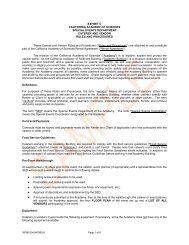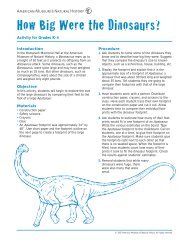Annual Report 2004–2005 - California Academy of Sciences
Annual Report 2004–2005 - California Academy of Sciences
Annual Report 2004–2005 - California Academy of Sciences
Create successful ePaper yourself
Turn your PDF publications into a flip-book with our unique Google optimized e-Paper software.
PROTECT<br />
Since its inception, the <strong>Academy</strong> has been a leader in the field <strong>of</strong> conservation, serving<br />
as the first home <strong>of</strong> the Sierra Club, advocating for the protection <strong>of</strong> endangered species<br />
in <strong>California</strong>, and supporting environmental protection efforts in Yosemite as early<br />
as 1863. Today, we take an integrated approach to conservation – from hands-on<br />
programs for citizen scientists to innovative exhibits that inform and inspire – all<br />
rooted in <strong>Academy</strong> research that spans the globe.<br />
Madagascar Biodiversity Project<br />
Ten years ago, in collaboration with the National Zoo in<br />
Madagascar, the <strong>Academy</strong> developed the Madagascar Biodiversity<br />
Project, a research and conservation strategy driven<br />
by the urgent need to map biodiversity in Madagascar. Today,<br />
led by <strong>Academy</strong> entomologist Brian Fisher, a team <strong>of</strong><br />
Malagasy students and scientists conducts biological inventories<br />
in threatened habitats in Madagascar, then translates<br />
and applies the results to conservation. Collecting baseline<br />
data is the first step toward making informed decisions<br />
about conservation, and training Malagasy scientists to become<br />
participants in policy-formation in their country is<br />
critical to ensuring long-term commitment to the preservation<br />
<strong>of</strong> this unique island.<br />
Ants: Hidden Worlds Revealed<br />
Based on Dr. Fisher’s work in Madagascar, Ants: Hidden<br />
Worlds Revealed was the <strong>Academy</strong>’s first exhibit to debut<br />
at Howard Street, showcasing six colonies <strong>of</strong> live ants. The<br />
exhibit covered ant basics (what an ant is and how its life<br />
cycle functions), while exploring more complicated topics<br />
such as the negative impacts <strong>of</strong> invasive ant species, worldwide<br />
efforts to conserve ants, and why conservation is important.<br />
Ants engaged visitors through live animals, video<br />
clips, and feedings combined with short presentations by<br />
<strong>Academy</strong> biologists—impressing upon visitors the great<br />
impact these small creatures have on entire ecosystems.<br />
Bay Area Ant Survey (BAAS)<br />
A collaborative project between <strong>Academy</strong> scientists, educators,<br />
local school groups, and museum visitors, the BAAS<br />
uses specimens and data gathered by the public to build<br />
a geographically-referenced inventory <strong>of</strong> Bay Area ant species<br />
and promote conservation. Participants are given an<br />
orientation to BAAS and their own ant collecting kit and<br />
can utilize identification keys and GIS reference maps in<br />
the <strong>Academy</strong>’s Naturalist Center.<br />
Since July 2004, more than 400 participants have collected<br />
more than 6,500 ants and discovered 14 new county records<br />
in the Bay Area, proving that people <strong>of</strong> all ages and<br />
experience can help explore, explain, and protect the natural<br />
world.<br />
7


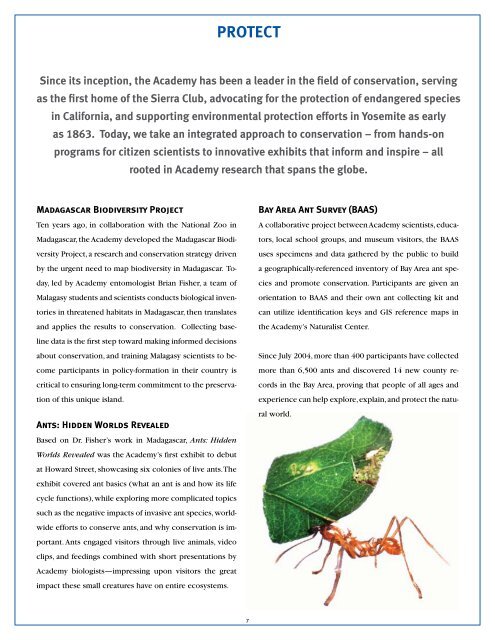
![download [PDF - 2.7mb] - California Academy of Sciences](https://img.yumpu.com/26596748/1/190x122/download-pdf-27mb-california-academy-of-sciences.jpg?quality=85)

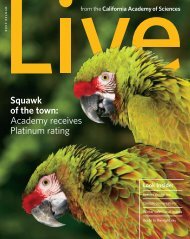

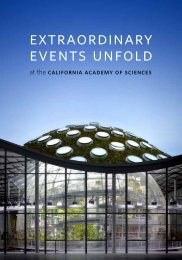

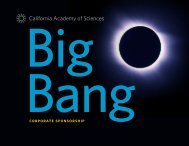
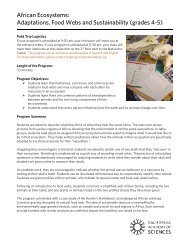
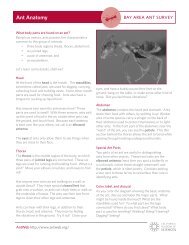
![Download a visitor map [418k] - California Academy of Sciences](https://img.yumpu.com/26596645/1/190x88/download-a-visitor-map-418k-california-academy-of-sciences.jpg?quality=85)
